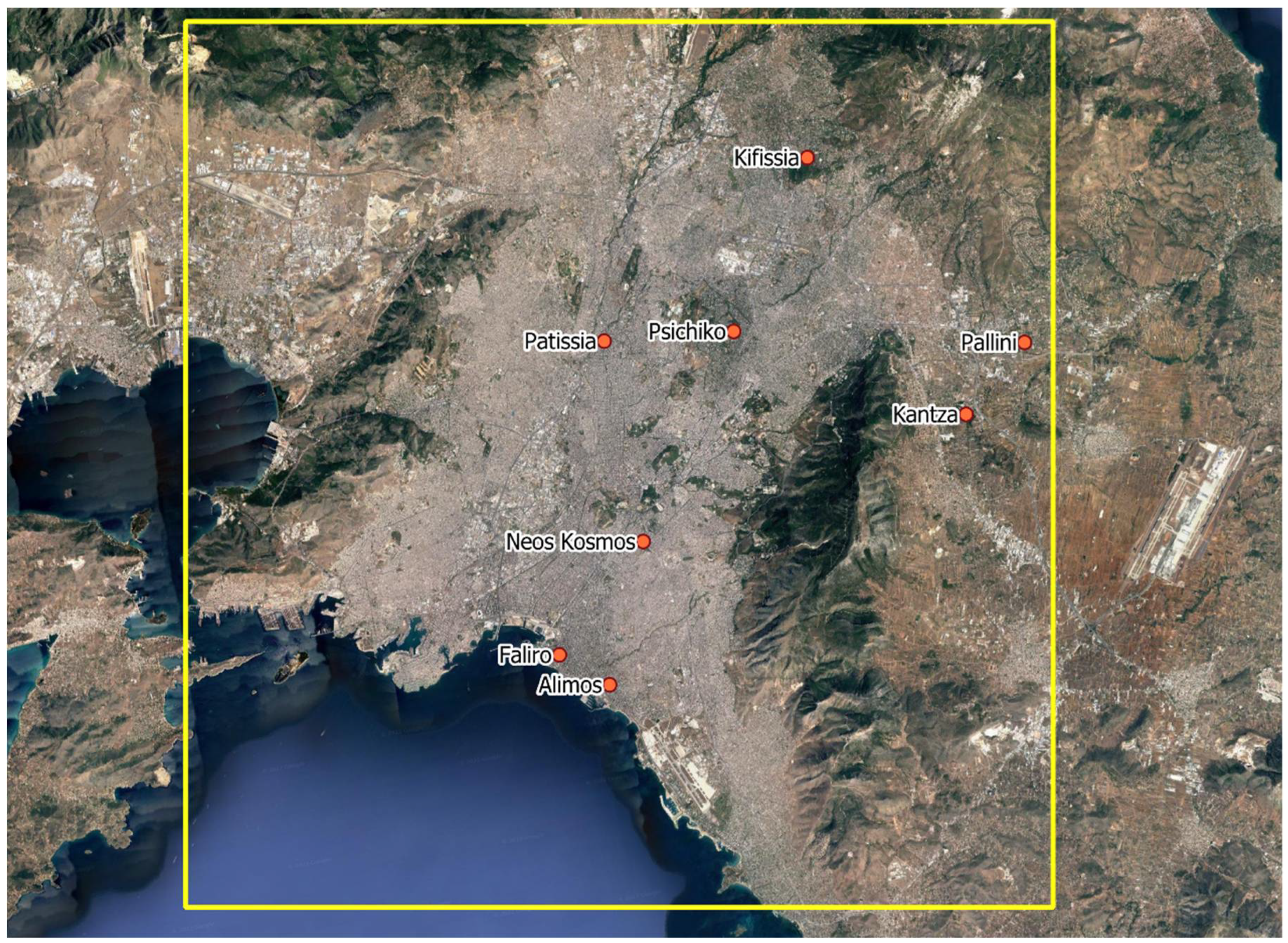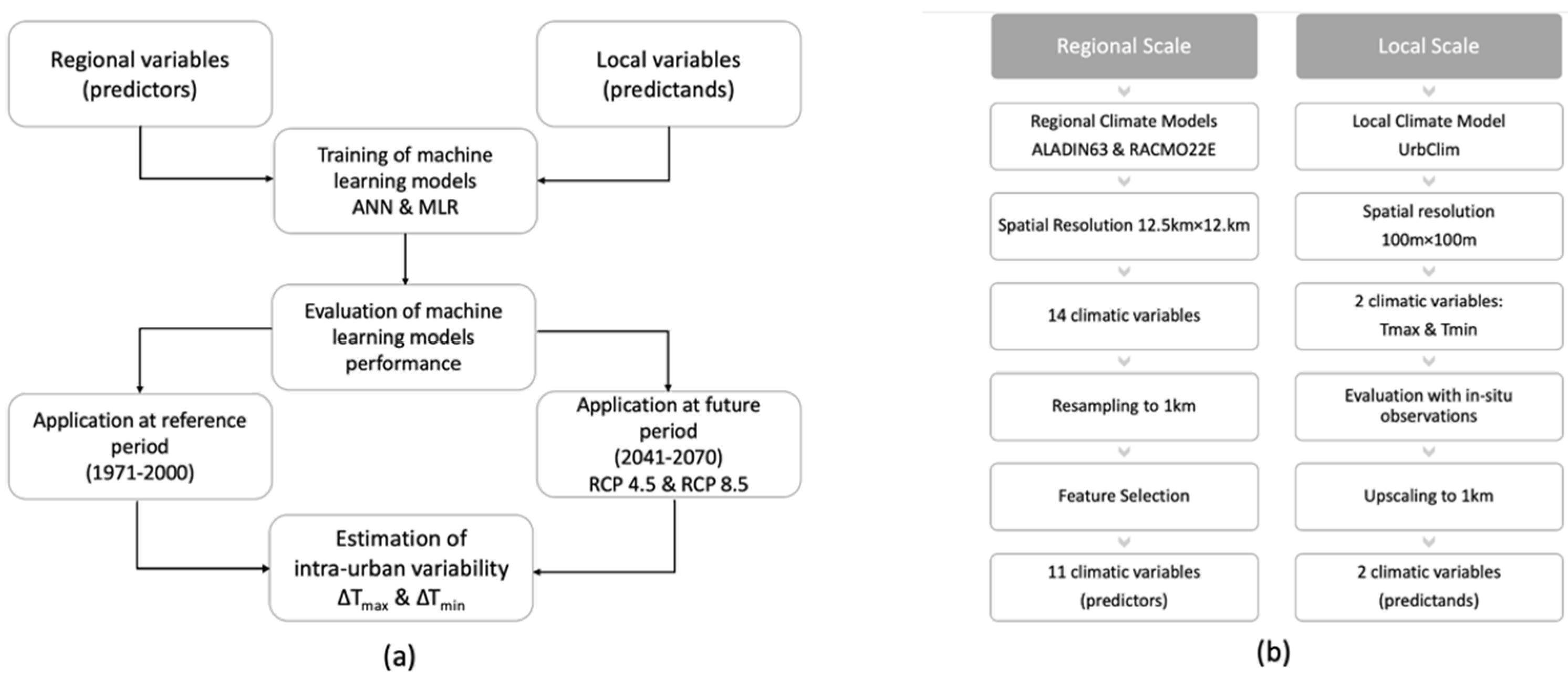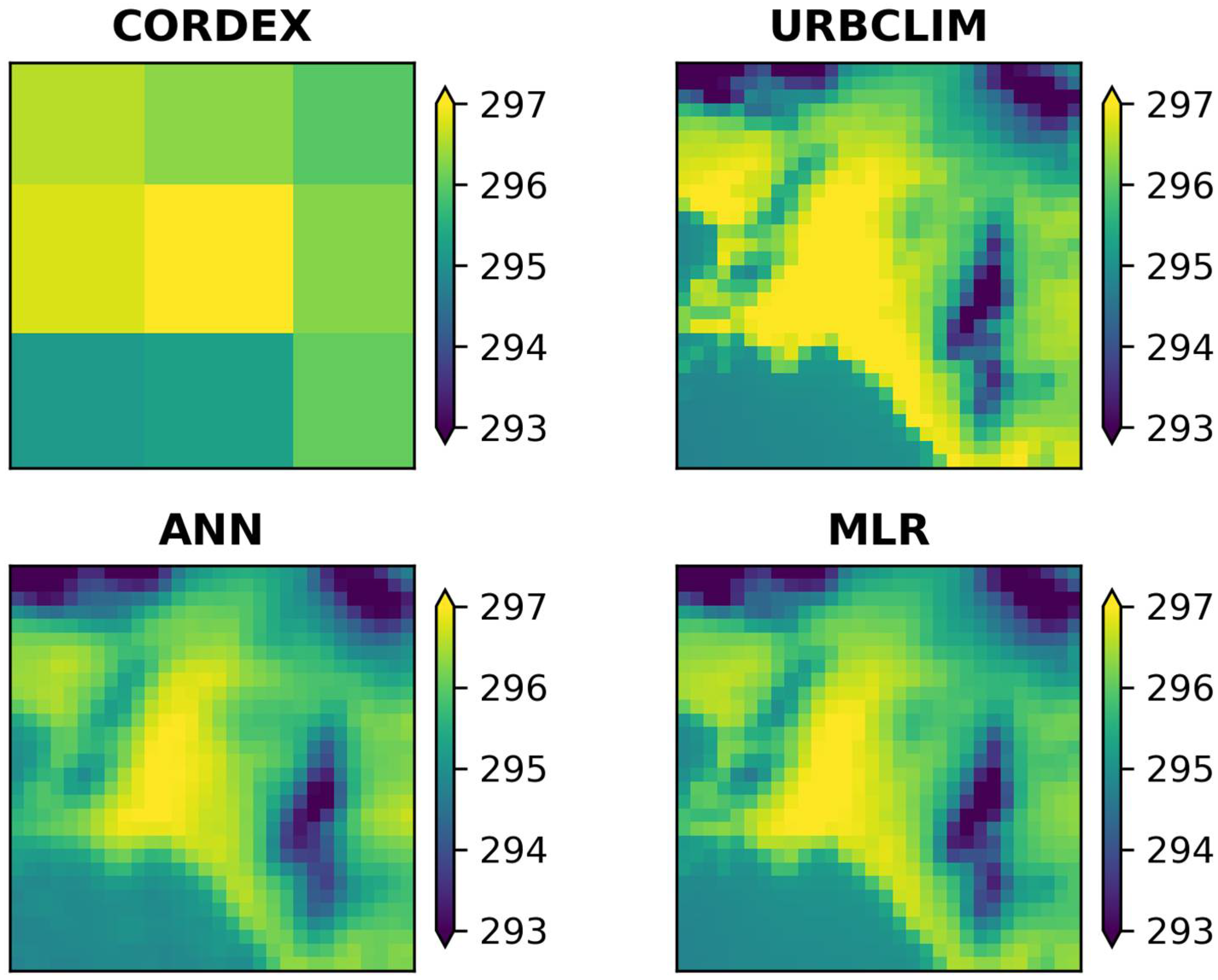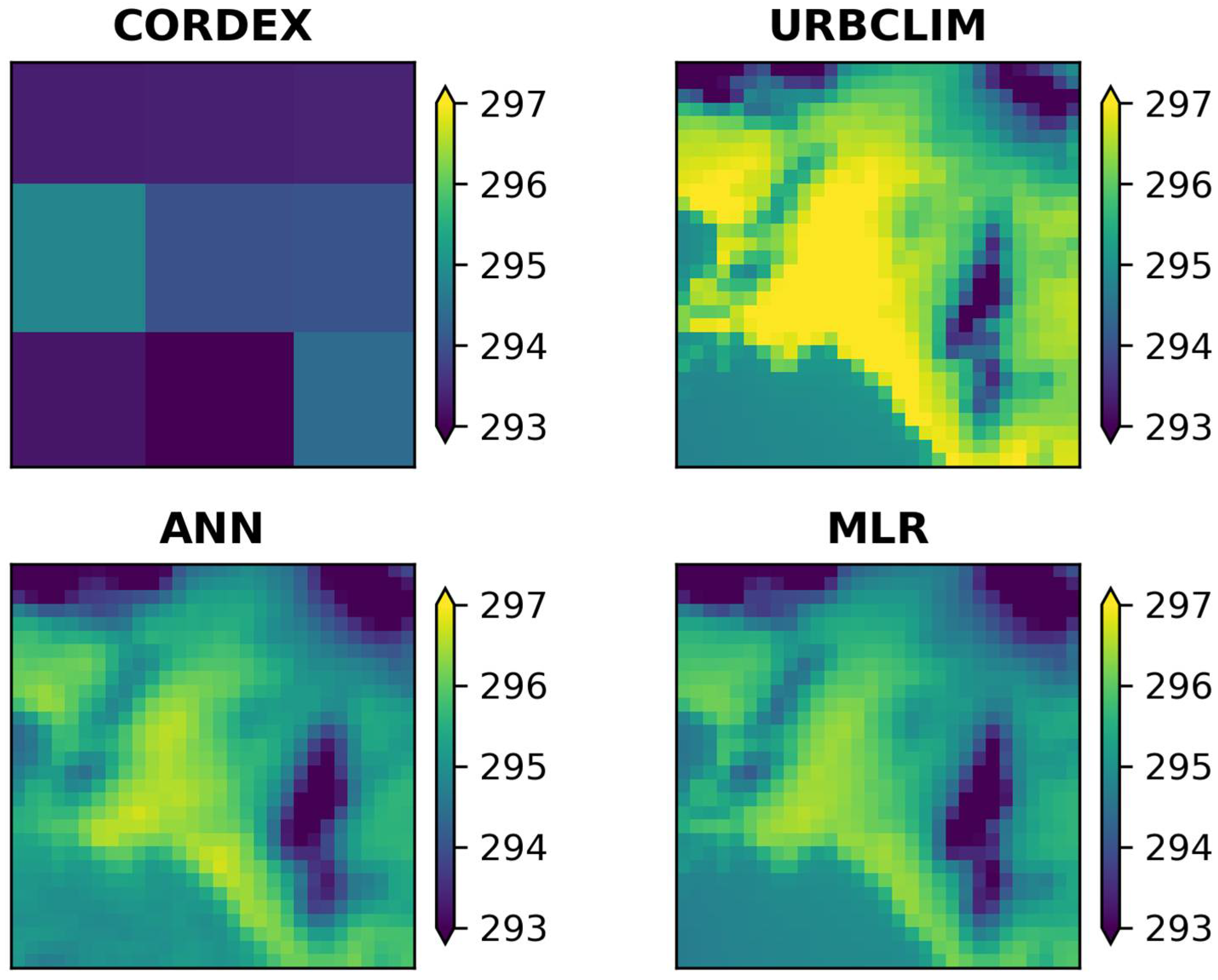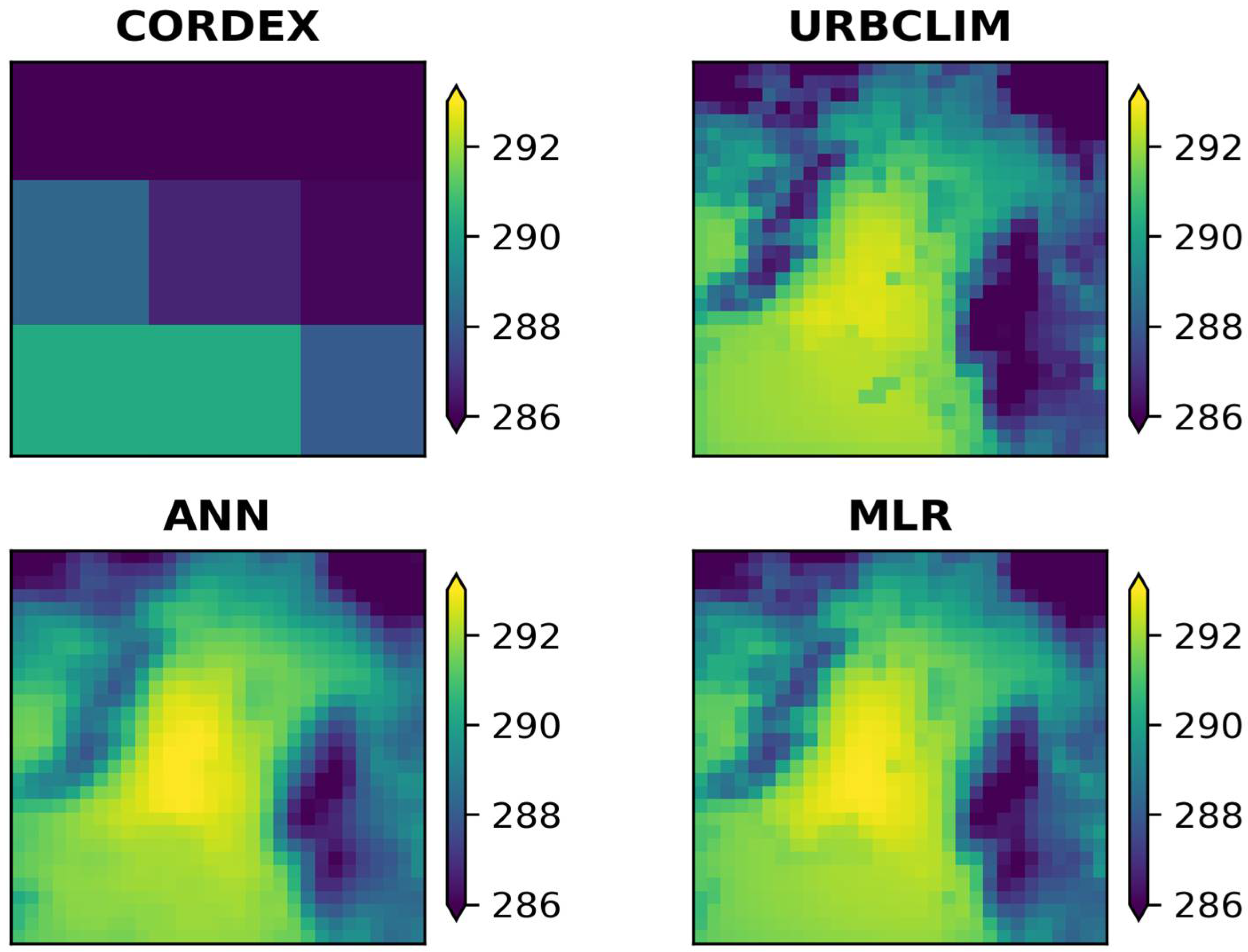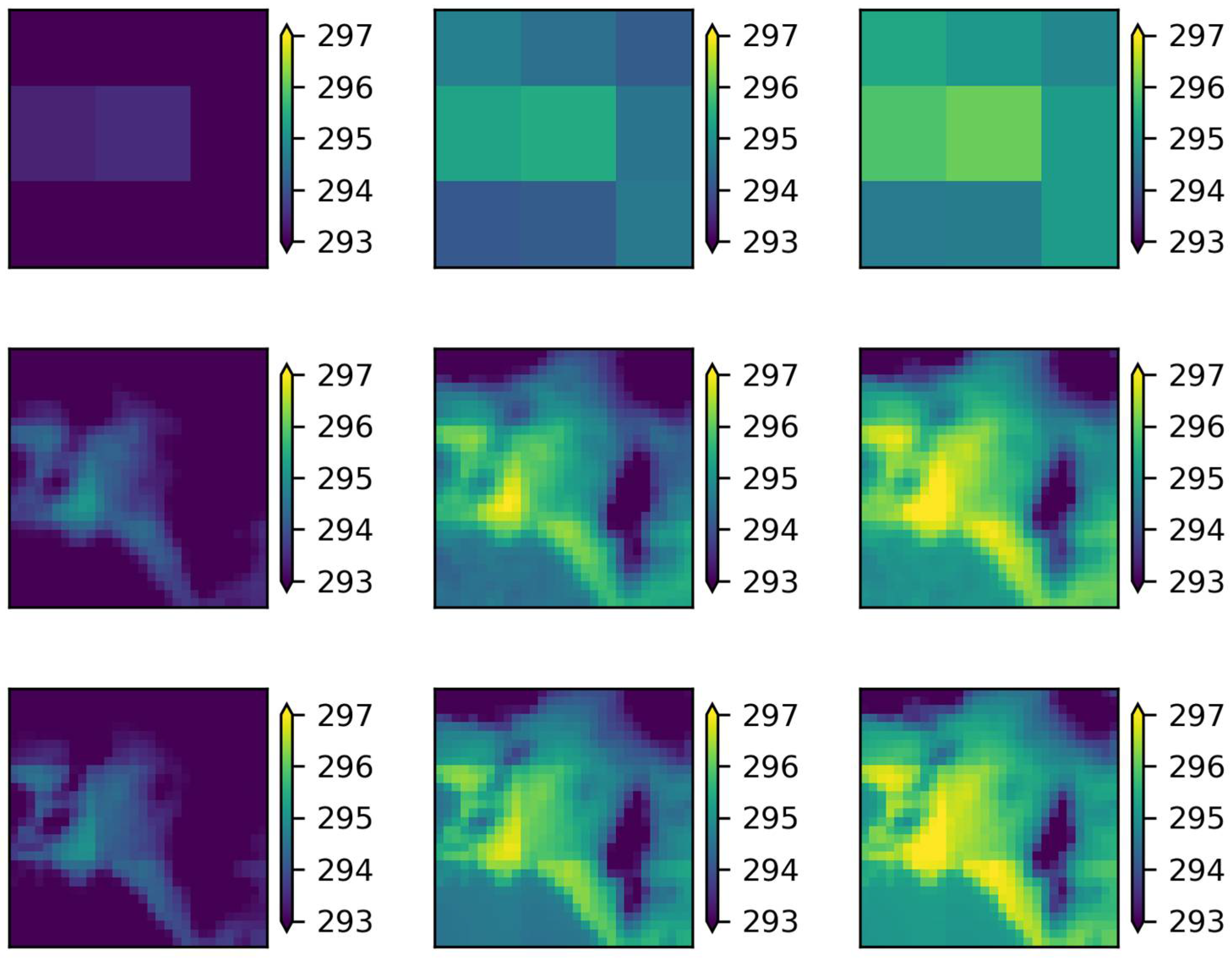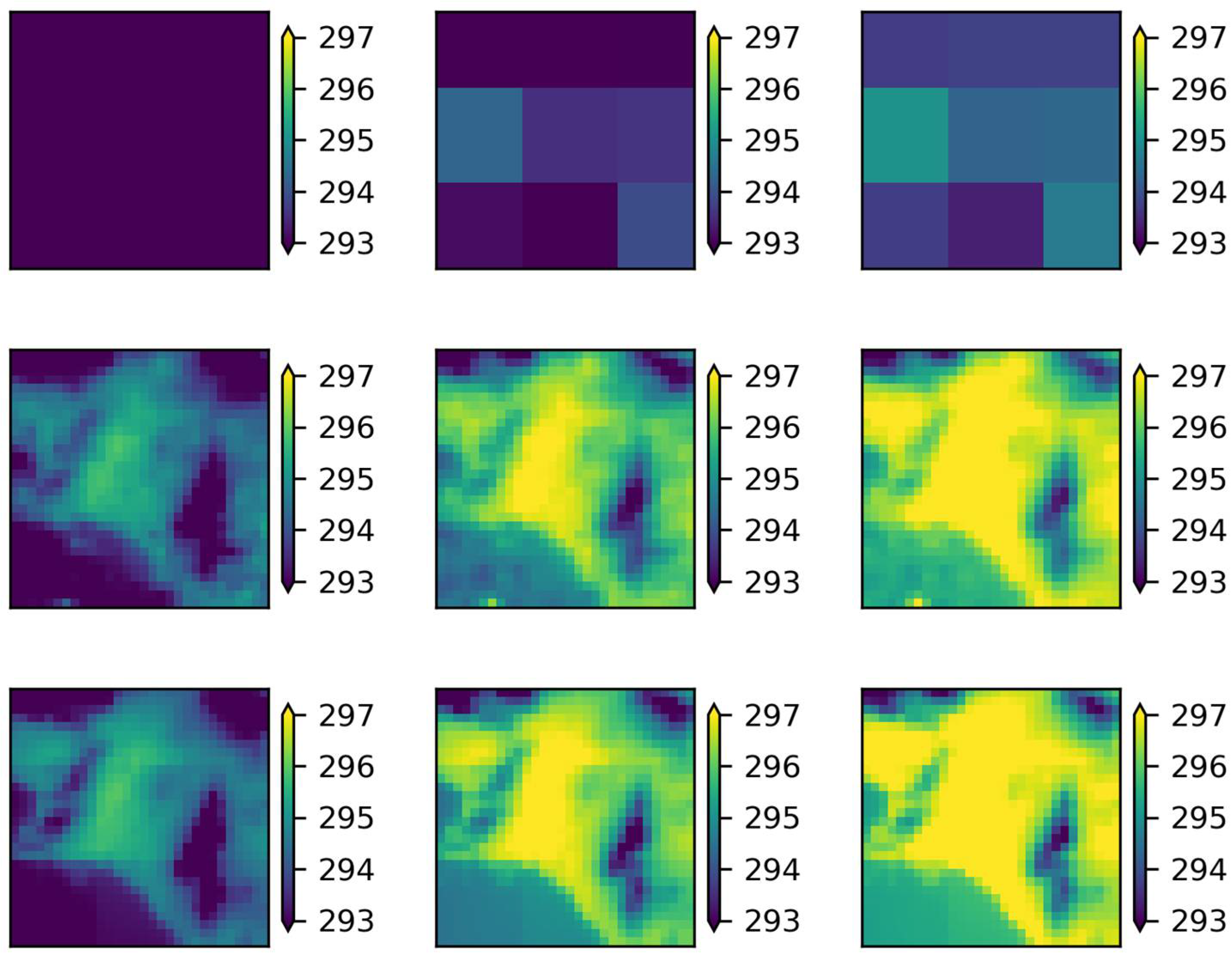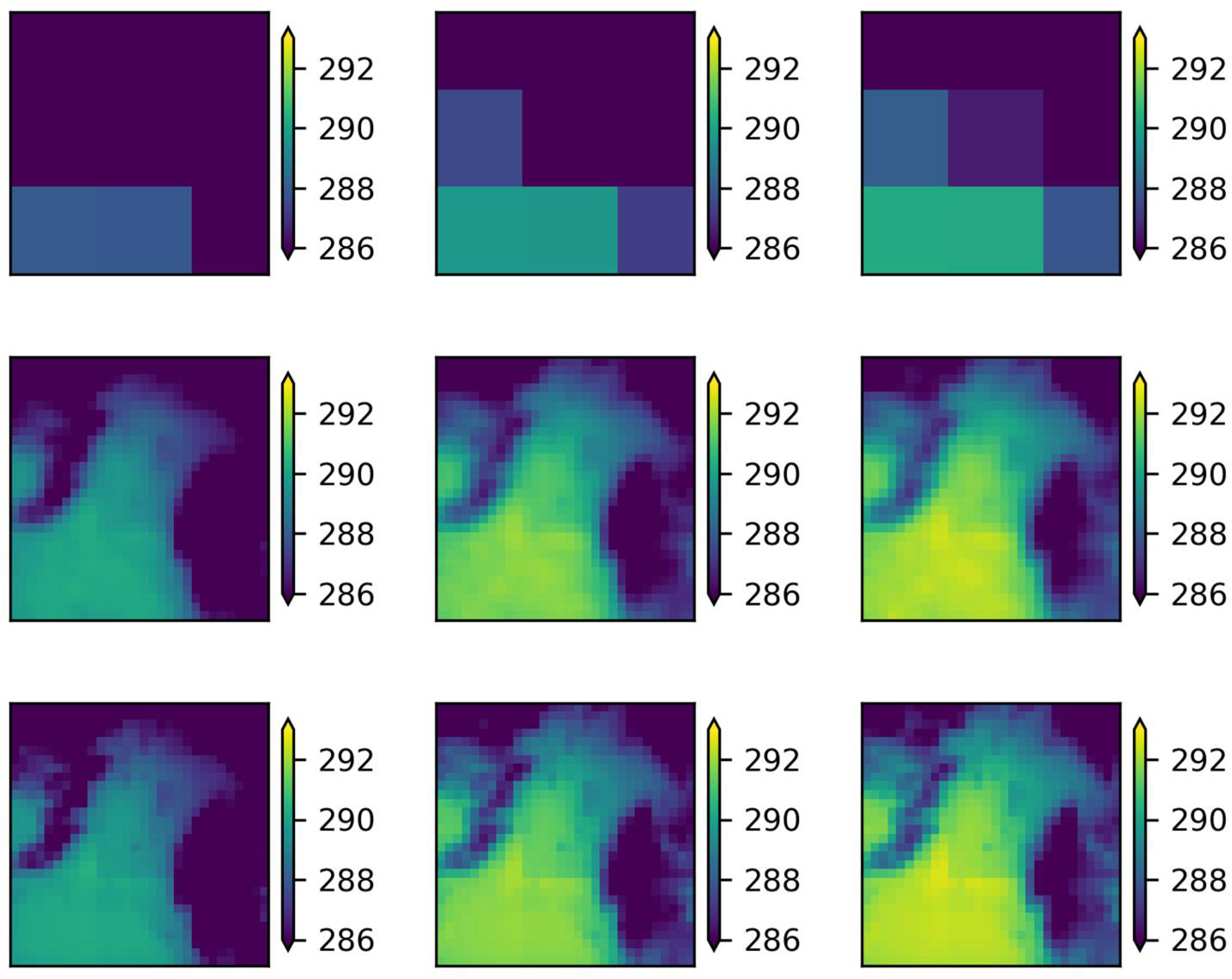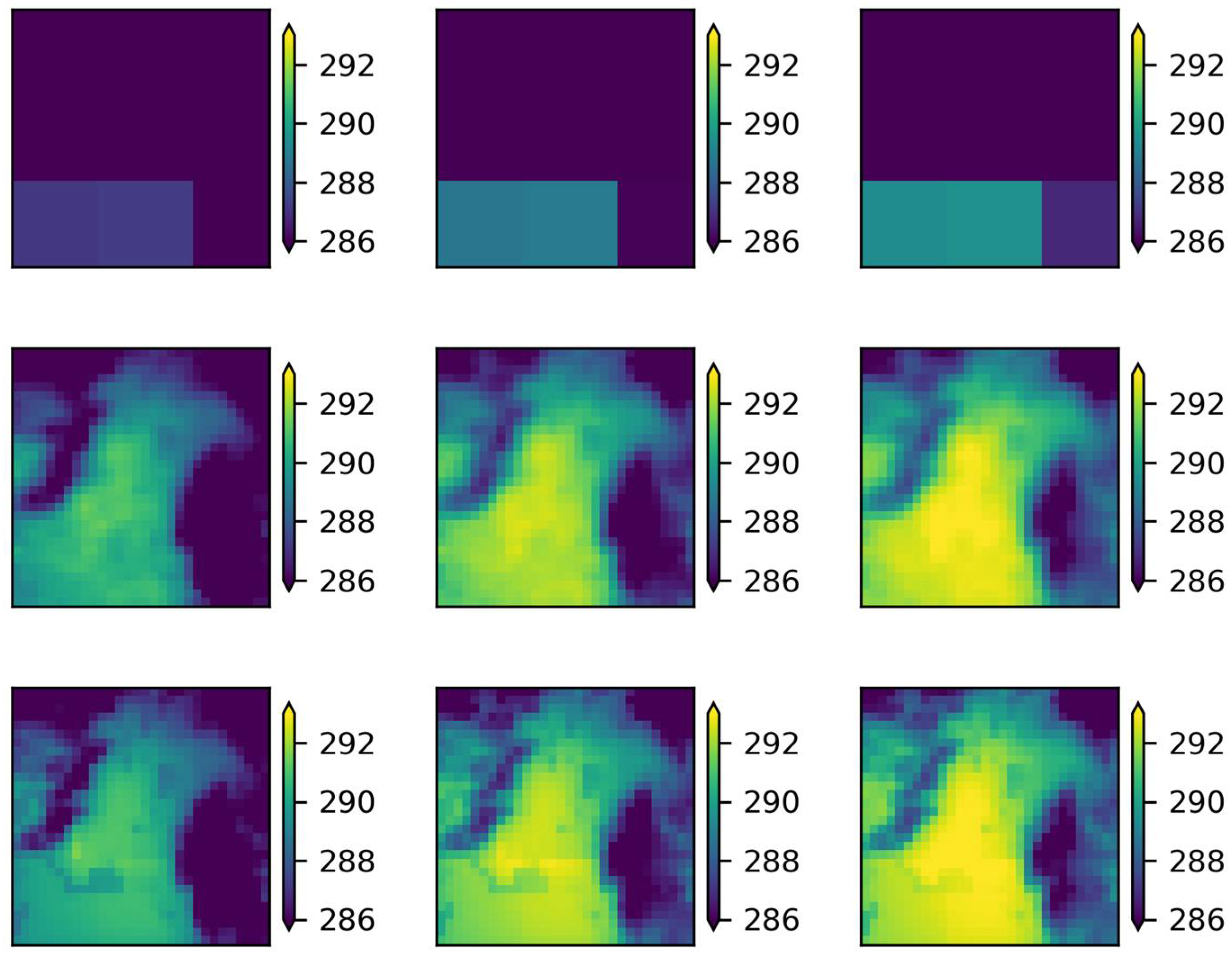1. Introduction
Long-term observational records provide ample evidence of an increase in the mean global air temperature due to anthropogenic climate change [
1]. Additionally, in recent years an unusual frequent number of record-shattering temperature extremes, often accompanied by heat-related mortality [
2], have been observed. These extreme weather events are projected to increase in intensity and recurrence [
3,
4], becoming up to seven times more probable within the next 30 years [
5]. The impact of excessive heat is expected to be more severe in urban areas as it adds to the existing warming from the urban heat island (UHI) effect [
6]. The lack of appropriate frameworks and high-quality data is a crucial aspect that limits climate-informed decision-making. The urban environment is characterized by high heterogeneity with different types of land use. High-frequency and complex transitions of urban characteristics (e.g., building height, imperviousness density, canyon aspect ratio) pose the need for high-resolution data in order to define the intra-urban vulnerability to climate change and, subsequently, to introduce spatially focused adaptation and mitigation measures. For instance, although urban flooding is an inevitable natural hazard [
7], climate information can provide the required level of scientific evidence for drafting flood adaptation/mitigation measures that can lead to efficient management. Furthermore, high ambient temperatures and heat waves cause adverse impacts on human health [
8]; however, their intra-urban variability introduces different magnitudes of exposure and, hence, the lack of high-resolution data leads to insufficient public decision measures. Moreover, excessive urban heat influences the energy demand of buildings (increased for cooling and decreased for heating) [
9]. Thus, solutions such as building renovations and retrofitting can contribute to reducing energy consumption through energy efficiency upgrades, but without data at a finer resolution, their prioritization would not be optimum.
Hence, cities are characterized as hotspots of climate change impacts and risks and the proposed methodology can contribute to limiting the uncertainties related to the intra-urban variability of air temperature. Improved high-resolution climate projections for the urban thermal environment are of great relevance, taking into account the need for developing adaptation measures.
Global circulation models (GCMs) simulate the Earth’s climate via mathematical equations that describe atmospheric, oceanic, and biotic processes, interactions, and their feedbacks [
10]. GCMs provide future climate scenarios at a coarse spatial and temporal resolution, and, therefore, their results are inadequate for use in climate impact models. As a consequence, the need for higher-resolution data that can be used for regional and local studies led to the development of different downscaling methods [
11]. There are mainly two downscaling approaches, the “dynamic” and the “statistical”.
The first approach relies on the use of a regional climate model (RCM), which is nested within a GCM and covers a limited spatial domain. The reduction of the simulated area allows the introduction of more detailed descriptions of physical processes and surface topography and, hence, generates more realistic climate information [
12]. Since the RCM is driven by the GCM output, its overall quality is directly related to the biases of the latter one (Storch and Chen, 2001). A single RCM will probably not provide “accurate” results and, thus, projects that utilize various RCMs driven by multiple GCMs from the Coupled Model Intercomparison Project Phases have been developed to produce multi-model ensembles of regional-scale projections. The EURO-CORDEX framework oversees the design and coordination of ongoing ensembles of climate projections for the region of Europe at a spatial resolution of 0.11° (EUR-11) and 0.44° (EUR-44) [
13].
Even though RCMs have a significantly finer resolution than GCMs, locally focused studies, such as species distribution, forest growth, and ecosystem modeling studies, require higher-resolution data [
14,
15]. However, local factors are not resolved by even the finest RCMs [
16] and, consequently, further downscaling is necessary to include more detailed information about coastal, orographic, and land-use features to capture local-scale processes.
As far as urban areas are concerned, their specific characteristics such as the high heterogeneity of the surfaces in combination with their size require the performance of high-resolution models since the detailed representation of the land cover and its physical properties are crucial for impact studies [
17]. Downscaling RCM outputs to an urban scale provides useful information on climate change scenarios and, therefore, contributes to the development of adaptation planning and mitigation strategies by the city planners.
The second approach includes statistical downscaling (SD) methods [
18] aiming to bridge the gap between large and local scales and establish empirical relations between coarse-resolution predictors and smaller-scale historical observations of the climate variable of interest (predictand). A vast number of SD techniques have been developed [
19]; a common assumption for all is that the currently observed relationships will be upheld in the future, i.e., that a stationary statistical relationship exists. Depending on the nature of predictors, observed or simulated, SD is divided into two further subcategories: (a) perfect prognosis (PP) [
20,
21,
22] and (b) model output statistics (MOS) [
18,
23,
24].
Under PP, the statistical link is typically calibrated between daily quasi-observed data from reanalysis datasets (predictors) and the simultaneously observed predictand. To infer the statistical relationship, a suitable choice of predictors should include large-scale variables that account for a high proportion of the variability of the predictand and are well presented by both reanalysis and climate models [
19,
25].
Conversely to PP, MOS derives local-scale climatic information linking model-simulated features to the target variable. An important advantage of MOS is the ability to explicitly account for model-inherent biases and errors [
26]. As most simulation outputs are typically generated with a free-running GCM or a GCM-driven RCM experiment, MOS methods are usually limited to calibrations based on long-term distributions of the climate variables [
27]. Nevertheless, using GCM outputs nudged to reanalysis [
25] or reanalysis-driven historical RCM simulations, MOS can also be applied in an event-wise context similar to that of PP [
26,
28]. For both distribution-wise and event-wise cases, MOS relations are specific only to the climate model upon which they have been established.
For urban areas, a wide range of downscaling methodologies were recently proposed in order to derive future climatic conditions with improved detail and accuracy. Dynamical downscaling of GCMs through nested RCMs was found to provide added value to urban areas, especially for coastal cities; however, important urban thermal dynamic processes are not sufficiently captured [
29,
30]. A full dynamical approach from the global scale down to the urban scale [
31], albeit the most physically valid and consistent methodology, is usually not preferred, given its considerable computational cost [
32].
Hence, both SD methods of PP [
33,
34] and MOS [
35,
36,
37,
38] are widely common for urban areas, with the latter typically applied as a quantile mapping bias correction. Simple SD methods largely lack, however, the ability to represent the intra-urban variability of urban areas or to capture complex interactions [
32]. Therefore, a hybrid statistical-dynamical downscaling (SDD) scheme is increasingly being employed in order to make best use of the respective benefits of each individual approach [
17,
32,
39,
40,
41,
42]. To accomplish this, a fine-scale simulation is initially conducted for the urban area under consideration, commonly for a relative short temporal period, the output of which is subsequently combined with large-scale GCM or RCM projections to provide downscaled urban climatic information.
This paper aims to bridge the gap between the regional climate model resolution (approximately 12 km) and the respective one at the local scale for improving the climate projections of the urban thermal environment. This work proposes an easily replicable data-driven workflow and a hybrid dynamical-statistical downscaling methodology that was developed for the Tmax and Tmin using both linear and nonlinear machine learning methods. Our aim is to provide a ready-to-use, high-resolution climate data product for decision support, adaptation planning, and mitigation policies. The methodology was applied in Athens and was used as a case study for identifying its predictive ability using both linear and nonlinear models in an area characterized by complex topographical features.
3. Results
3.1. Evaluation of High-Resolution Urban Climate Model Simulations
Daily Tmax and Tmin were initially computed from the hourly UrbClim time series. The nearest grid cell to each meteorological station (listed in
Table 2) was used to validate the UrbClim simulations with observations. In more detail, each meteorological station was allocated to a single UrbClim grid cell, and based on its geographical location (latitude-longitude coordinates) the corresponding pairs of “meteorological stations/UrbClim grid cells” were identified. The statistical errors, including the mean absolute error (MAE), mean absolute relative error (MARE), root mean square error (RMSE), mean bias error (BIAS), and correlation coefficient (R), were calculated for both T
max and T
min and the results are shown in
Table 3. Following the results of
Table 3, a good overall agreement was observed in all cases; the MAE ranged from 0.91 °C to 1.74 °C and from 1.36 °C to 1.94 °C for T
max and T
min, respectively. It should be noted that a higher accuracy was observed for T
max as all the statistical metrics indicated a superior performance compared to T
min (higher R and lower BIAS, RMSE, and MAE). The lower overall UrbClim performance was observed for the coastal Alimos station. According to our findings, all coastal stations exhibited a lower R value and higher MAE and RMSE values for T
max compared to all other sites. This could be attributed to a slight underestimation of the cooling effect of different local circulations, such as the sea breeze. The UrbClim simulations are considered to simulate adequately the spatiotemporal variations of T
max and T
min over Athens and, therefore, they could be used as a reference for the downscaling procedure. For greater accuracy, we evaluated the UrbClim simulations at the spatial resolution of 100 m prior to the upscaling to 1 km.
3.2. Feature Selection
The optimal predictor subset of climatic variables was determined using the NCA-based feature selection method, which assigns weights for each of the possible input variables (after standardization). The relative percentage weights for T
max and T
min are presented in
Table 4 for the initial subset of 14 climatic variables.
The number of input variables was reduced based on two criteria: (a) the weights of the selected variables that had the largest relative contribution, and (b) they represented 85% of the total weight. The 11 final selected variables were common for both T
max and T
min, even though they exhibit different relative contributions (i.e., weights), and are shown in bold in
Table 4.
3.3. Evaluation of Machine Learning Model Performance
The trained machine learning models that link the regional and local scales for each grid cell of the study area were applied for evaluation of the available data during 2012. More specifically, the values of the RCM variables were inserted in the models as predictors, and the obtained Tmax and Tmin results were compared with the corresponding UrbClim model simulations. This process was performed separately for each RCM model and each method (i.e., ANN and MLR).
The average annual results are presented in
Figure 4,
Figure 5,
Figure 6 and
Figure 7. Moreover, for a better comparison of the final (local) and initial (regional) scale, the temperature data of the regional models are also presented. It should be noted that for better visualization of the results, the temperature scale is the same for T
max and T
min.
Table 5,
Table 6 and
Table 7 below exhibit the average seasonal and annual MAE and BIAS statistical metrics, along with the R between the downscaling results and the UrbClim model simulations for both T
max and T
min and methods during 2012. The BIAS metric was calculated by subtracting the UrbClim values from the downscaling results; hence, positive values of BIAS exhibited overestimation of the temperature from the downscaling procedure. It should be also noted that the statistical errors were first calculated for each day and, subsequently, aggregated to their seasonal and annual values.
Table 5 shows that both methods exhibited similar results and that the MLR model was associated with slightly lower MAEs compared to the ANN in all cases. In general, the RACMO22E RCM exhibited lower MAEs than the ALADIN63 RCM and T
min had lower MAEs compared to T
max, except for in the winter. Regarding the seasonality of MAEs, the method exhibited a higher predictive ability during the summer (1.58 °C on average) and autumn (1.72 °C on average), indicating that the approach is very useful for the study of the urban thermal environment during the summer period when most of the heatwaves occur. The average MAE was 1.75 °C, which is sufficient for city-scale applications. It is worth noting that the values of MAE in each method and RCM were lower for T
min in the spring, summer, and autumn, whereas this was reversed in the winter where the lower values corresponded to T
max.
Regarding the overall BIAS error results, Tmax was found to have a negative BIAS in contrast with Tmin, which had mainly a positive BIAS. When focusing on seasonal BIAS, the ALADIN63 model had the lowest BIAS errors when the MLR method was applied from the spring to autumn, compared to the ANN method which had a lower BIAS in the winter. For the RACMO22E model, the BIAS errors for Tmin in the spring were lower with the ANN method; however, for the rest of the seasons, no specific pattern was evident, neither for the ANN nor MLR methods.
The correlation analysis results indicated that a strong correlation exists in all cases, especially for the RACMO22E RCM. Regarding the correlation coefficient of Tmax, higher values were found for the MLR method when the ALADIN63 RCM was used, contrary to the RACMO22E RCM which exhibited the same high values of R regardless of the applied methodology.
Analyzing the corresponding maps in
Figure 4,
Figure 5,
Figure 6 and
Figure 7, it was observed that both RCMs and the two methods successfully simulated the spatial patterns of temperature for the study area as they highlight the differences between the mountainous and urban areas, which were not distinguished at the regional scale, and approach, to a large extent, the scale of the UrbClim model (e.g., intra-urban temperature differences). Focusing on the annual average spatial T
max distribution (
Figure 4 and
Figure 5), it was clearly observed that for both methods the mountainous and warmer urban areas of the western suburbs were accurately identified. Concerning the T
min results, for the ALADIN63 model (
Figure 6), the urban and mountainous areas’ temperature differences were well-identified; however, there was an underestimation of the T
min in the western part of the domain and an overestimation in its central area for both methods. The same applies in the case of the RACMO22E model (
Figure 7).
In conclusion, the relationships extracted from the ANN and MLR methods for the statistical downscaling of Tmax and Tmin to 1 km provided satisfactory results. This conclusion emerges both from the evaluation of the statistical analysis, since the R ranged from 0.93–0.97 and the MAE from 1.39–2.10 °C, as well as from the interpretation of the spatial temperature patterns over the domain under study.
3.4. Application of the Models at Historical and Future Periods
The ensemble of each grid-cell-trained ANN and MLR models were applied both in the historical 1971–2000 and in the future 2041–2070 periods. The application in the future period was applied for two different scenarios: the moderate RCP4.5 and the adverse RCP8.5. In addition, the methodology was applied separately for each RCM, initially for T
max and subsequently for T
min. The RCM results and projections of the 11 selected variables (predictors) were used to generate daily high-resolution maps of both T
max and T
min for the study area. Average monthly, seasonal, and 30-year climatological period maps were generated and compared in terms of the effect of climate change on the spatiotemporal distribution of T
max and T
min in high resolution over the study area. In
Figure 8,
Figure 9,
Figure 10 and
Figure 11, the average 30-year climatological period maps are presented for T
max and T
min of both RCMs upon the application of the ANN and the MLR downscaling methods. In
Table 8 and
Table 9, the results of the seasonal temperature differences between the reference historical and future periods for the two RCP scenarios are presented for both the ANN and the MLR methods.
Regarding Tmax, similar increases were identified for both models per scenario. More specifically, in the ALADIN63 model, both methods estimated that the largest increase will be observed during the summer season (approximately 2.2 °C for RCP4.5 and 2.5 °C for RCP8.5), and the smallest during the winter (approximately 1.5 °C and 2.1 °C for RCP4.5 and RCP8.5, respectively). Furthermore, the increased differences between the two scenarios for Tmax were estimated to be lower during the summer compared to the other seasons. Regarding the transitional periods, a stronger thermal signal was identified upon the application of both downscaling methods during the autumn as compared to spring for both RCMs under both RCPs. Looking at the RACMO22E model in more detail, the temperature increase was found to be approximately 1.8 °C for RCP4.5 and 2.55 °C for RCP8.5 for the ANN downscaling method during the autumn. An overall agreement was found for the spring, when the lowest Tmax increases were identified (1.3 °C for the moderate scenario and 2 °C for the adverse).
Regarding the seasonal variation of the average Tmin, the increase identified by each method was also very similar. For the ALADIN63 model, it was observed that the results obtained from the MLR method were about 0.15 °C higher than those from the ANNs. Furthermore, both methods in both scenarios predicted a larger increase in the summer of approximately 1.9 °C and 2.3 °C for RCP4.5 and RCP8.5. The smallest increase was predicted for the winter period, about 1.2 °C and 1.7 °C for the moderate and adverse scenarios, respectively. In the RACMO22E model, the results of the two methods were almost identical. In any case, the largest increase corresponded to summer and the smallest to spring. In the RCP4.5 scenario, the increase in the summer was about 1.9 °C and in the spring 1.1 °C, whereas in RCP8.5 it was 2.4 °C and 2 °C, respectively.
Furthermore, the results showed that, in general, the increase in the average Tmin is predicted to be smaller compared to Tmax. The only case this is reversed is in the summer period for the RACMO22E model, for the ANN method in both scenarios, and, also, in the spring for the RCP8.5 scenario.
4. Discussion and Conclusions
The present study focused on the statistical downscaling of two RCMs using two different methods, ANN and MLR. The aim was to identify the relationships between the regional and the local scale in order to improve the climate projections of the daily Tmax and Tmin in urban areas.
The developed models achieved a significant improvement for both the Tmax and Tmin projections compared to those of the initial RCMs and closely approached the local-scale spatiotemporal patterns of the UrbClim model simulations (e.g., the influence of the urban and the mountainous areas in Tmax and Tmin that could not be distinguished in the RCM simulations, but which stand out after downscaling the projections at 1 km).
In general, by comparing the two methods, it was observed that both the ANN and MLR performed reasonably well and were able to adequately reproduce both the Tmax and Tmin. The errors indicated that the two methods exhibited slight differences in accuracy. The MLR method had lower MAE values, whereas the ANN was associated with systematically lower BIAS. Considering the Tmax and Tmin spatial distribution, it was observed that the MLR had more uniform temperature fields, and the influence of the RCMs seemed to be greater. On the other hand, this effect was eliminated in the ANN.
Regarding the evaluation results of the dynamical-statistical downscaling method (simulations for 2012), it was observed that the Tmin was better approximated by both methods in the spring, summer, and autumn, whereas the opposite was observed for the winter season. Moreover, the values of the statistical metrics and the differences in their spatial distributions when compared to the UrbClim simulations (i.e., map comparison), showed that the best results were found during the summer, followed by spring and autumn.
In addition, the application of the models for the reference historical and future periods showed that, even though each RCM temperature projections differed, the differences that arose between the two time periods converged to almost the same values. This agrees with the fact that RCMs are more capable of predicting temperature change in the future than their absolute value. The change in the average Tmax and Tmin between the two methods was similar, and larger increases were observed for Tmax and Tmin during the summer.
In agreement with previous studies, this study concludes that there is no one single satisfactory solution for downscaling Tmax and Tmin, since both the ANN and the MLR methods had both advantages and disadvantages. In the present study, the two methods were used to establish transfer functions with different levels of complexity between the associated scales. An inherent advantage of using ANN models is their ability to model nonlinear relationships, whereas the MLR models can be used upon training to establish linear transfer functions. A drawback of using the ANN in the context of downscaling climate information in the urban environment is the requirement of a representative long-term training dataset. On the other hand, MLR methods follow a simpler training procedure that could provide sufficient results with significantly lower demands in terms of training. Upon availability, both approaches can be further enhanced through the use of auxiliary variables such as urban morphological characteristics. ANNs compared to MLR models can be used more efficiently to model extreme values through optimizing the training process and solving the overfitting issue effectively. Therefore, the appropriate choice of the downscaling method is related to both the complexity of the relationship between the two scales and the availability of high-resolution urban climate information. However, it should be noted that in the case of scarce data availability, the approach of a fully dynamical downscaling process through cascade modeling could be the optimum solution for urban impact studies. The choice of the appropriate method should be investigated each time and should be based on the spatial and temporal requirements of each study.
In a future study, the selection of different predictor variables for each method and/or each regional model could be investigated. An upper-atmospheric predictor could be used, such as the thickness layer between 1000–500 hPa or the 500 hPa geopotential in order to provide the models with more information from the general atmospheric circulation. In addition, an ensemble of regional climate models could also be used which would improve the accuracy of the estimates and reduce uncertainty. Moreover, the number of downscaling methods could be increased by applying, for example, the delta method or weather type classification. The overall framework could be applied to an even finer spatial resolution and simulations with the atmospheric WRF (Weather Research and Forecasting) model could be performed to generate and use high spatial resolution data in urban areas.
The urban climate depends on urban morphology parameters such as land cover and building height, among others, which are not directly considered in this study but have a direct influence on the meteorological parameters that were used for the downscaling techniques. To this end, the results of this work are useful for the assessment of the intra-urban spatial and temporal variability of the urban thermal environment and, therefore, could contribute to the identification of specific areas where adaptation plans should be prioritized.
In addition, the results are valuable for addressing urban climate change, and provide a methodology for practically assessing the state of the urban thermal environment at a finer scale in future climate scenarios. Accordingly, they serve as scientific evidence with respect to the strong need for the strengthening of the adaptive capacity and resilience of cities to climate change.
